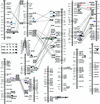Comparative analyses of genomic locations and race specificities of loci for quantitative resistance to Pyricularia grisea in rice and barley
- PMID: 12601171
- PMCID: PMC151377
- DOI: 10.1073/pnas.0437898100
Comparative analyses of genomic locations and race specificities of loci for quantitative resistance to Pyricularia grisea in rice and barley
Abstract
Comparative genomic analyses have revealed extensive colinearity in gene orders in distantly related taxa in mammals and grasses, which opened new horizons for evolutionary study. The objective of our study was to assess syntenic relationships of quantitative trait loci (QTL) for disease resistance in cereals by using a model system in which rice and barley were used as the hosts and the blast fungus Pyricularia grisea Sacc. as the pathogen. In total, 12 QTL against three isolates were identified in rice; two had effects on all three isolates, and the other 10 had effects on only one or two of the three isolates. Twelve QTL for blast resistance were identified in barley; one had effect on all three isolates, and the other 11 had effects on only one or two of the three isolates. The observed isolate specificity led to a hypothesis about the durability of quantitative resistance commonly observed in many plant host-pathogen systems. Four pairs of the QTL showed corresponding map positions between rice and barley, two of the four QTL pairs had complete conserved isolate specificity, and another two QTL pairs had partial conserved isolate specificity. Such corresponding locations and conserved specificity suggested a common origin and conserved functionality of the genes underlying the QTL for quantitative resistance and may have utility in gene discovery, understanding the function of the genomes, and identifying the evolutionary forces that structured the organization of the grass genomes.
Figures

References
-
- O'Brien S J, Eisenberg J F, Miyamoto M, Hedges S B, Kumar S, Wilson D E, Menotti-Raymond M, Murphy W J, Nash W G, Lyons L A, et al. Science. 1999;286:458–481. - PubMed
-
- Gale M D, Devos K M. Science. 1998;282:656–659. - PubMed
-
- Paterson A H, Lin Y-R, Li Z, Schertz K F, Doebley J F, Pinson S R M, Liu S-C, Stansel J W, Irvine J E. Science. 1995;269:1714–1718. - PubMed
-
- Gale M D, Flintham J E, Devos K M. Euphytica. 2002;126:21–25.
Publication types
MeSH terms
LinkOut - more resources
Full Text Sources
Research Materials

